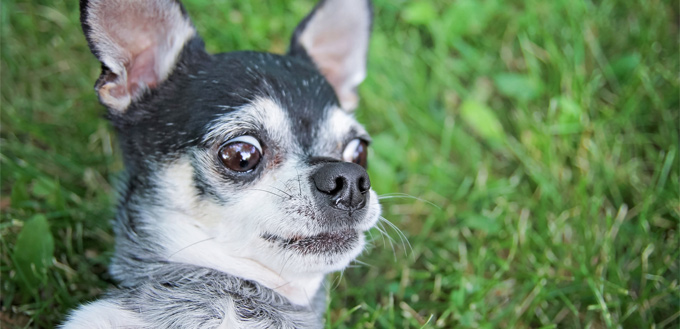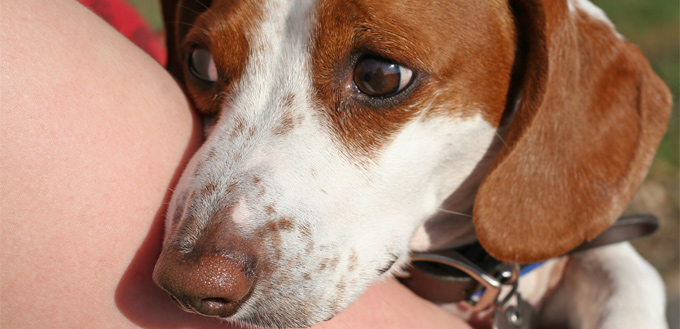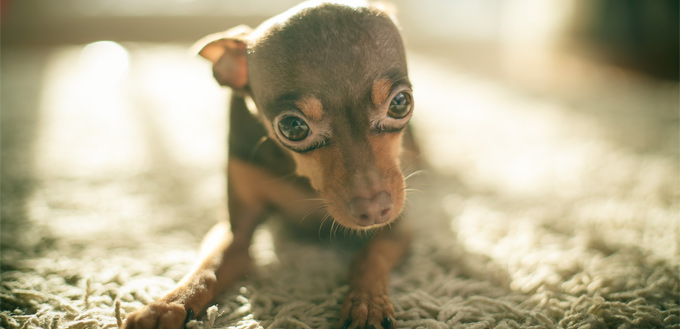It can easily become worrying when your dog is displaying signs of fear over small, seemingly insignificant activities and objects. Yet, dog phobias are extremely common. Our canine companions often struggle with anxiety, and dog fears can be related to anything, the same way our own phobias can wreak havoc with our physical and mental wellbeing.
While it’s important to always speak to your vet about any sudden changes in your dog’s behavior, we also understand that those who know about their dog’s phobias will be seeking natural ways to help your dog become calmer and happier. Below, we take a look at some of the most common fears your dog may have and discuss ways to help your dog with their anxiety.

Fireworks
Possibly the most common and widespread dog phobia. It’s no secret that most dogs fear fireworks. The incessant banging so close to home can create a night of hell for your pup and- unfortunately for us dog lovers- these fireworks come around at least once a year.
For some, it’s because your dog fears loud noises while, for others, it is simply due to the lack of understanding of what is going on. This can be especially true for those whose dogs are particularly territorial. As far as they’re concerned, there is a threat nearby that wants to barge in on the home of his or her pack. Woof woof, indeed. To make matters worse, the bangs are sporadic, accompanied by flashing lights and the source can’t be located. It really isn’t surprising that dogs feel threatened and anxious around fireworks!
Thunderstorms
Running along a similar theme to fireworks, a lot of dogs fear thunderstorms because the loud bangs and flashing lights can create confusion and anxiety. Not to mention that the low rumbling of thunder certainly sounds similar to their own warnings- a good, long growl.
Of course, your dog’s phobia of thunder is only made worse by the inability to find the source of the thuds and groans of a storm. In particular, the flashing lights can disorientate your four-legged friend, which explains why they will usually try and find a place to hide during thunderstorms.
Cars
Perhaps a little less common and attributed to many different aspects is a dog’s fear of cars. Personally, I have owned border collies for most of my life, so tend to find my little pups prefer to chase cars and buses rather than hide from them (thanks, natural herding instinct!). The reason for this is the grumbling sound that our preferred transportation creates- which is the exact same reason that many dogs run away from cars.
Essentially, the chugging of the engines as they go past simply sounds threatening to them. Add to that the speed of some drivers and the honking horn that even catches us, humans, off-guard more than we’d like to admit! Cars are an unknown quantity to dogs and, as such, dogs develop phobias of them. It’s completely understandable if a little frustrating!
The worst part about your dog becoming anxious around cars and engines, in general, is that they may even refuse to enter your own car! For them, this is the equivalent of locking them in a box with a loud, noise-making, angry machine that they can’t escape from. There is hope, however. Check out our tips, below if your dog’s phobia of cars is getting you down.
Separation Anxiety
Dogs are pack animals. Meaning that you, their family, are their whole world. Unfortunately, a sad part of life is having to leave your loved ones from time-to-time, whether for work or even just nipping out to the shops. Dogs who suffer from separation anxiety tend to show their fear through barking and/or whining, chewing furniture, scratching at the door, and floors in an effort to follow you and vomiting/defecating.
Understandably, this can be extremely distressing for everyone involved. Nobody wants to see someone they love under so much stress, especially as you often don’t discover this phobia until you’ve returned and discovered your house has been ruined! Coming home to find that your dog has separation anxiety can create more stress in the house, especially when it comes to leaving again.
Of course, this creates more anxiety for your dog, as you become tense as you leave, over-compensating with praise or punishment, and, ultimately, creating a cycle of fear that becomes harder to break. If this is something you’re struggling with, take a look at our tips below for helping your dog overcome their fears.
Kids
Your dogs fear of children can be especially dominant in rescue pups. Unfortunately, since these dogs tend to come from difficult backgrounds, they may struggle with socializing in general. Tiny humans with high voices and excitable personalities can create anxiety in your dog, purely because they aren’t sure about what the intentions of kids are.
This isn’t to say that your dogs fear of children can’t be overcome. In fact, rescue dogs can be the most loving and caring animals you will ever have the pleasure of adopting. Not to mention that this fear can also come from “shop” dogs who haven’t been handled by kids or haven’t socialized with your little ones. It doesn’t mean that these dogs are not good dogs, or that they are unsafe around children- it simply means that a little understanding and care for both your dog and the children around it can help ease your dog’s phobia of kids.
Vets
It starts as soon as you open the door. The smell of chemicals and other animals hits your dog, whose nose has 220 million receptors (compared to our measly 5 million)- meaning they immediately turn tail and try to run. It’s not hard to understand why dogs fear vets.
Indeed, a dog’s phobia of vets is certainly very relatable! After all, how many people do you know who hate the dentist or doctors? Nobody wants to sit on a table and be poked and prodded by a stranger. Especially when they start putting things in places.
Strangers
As mentioned previously, dogs are pack animals. They want and need the protection of each other and their family to be happy and healthy. That said, while some dogs are perfectly happy accepting strangers around themselves and their home, other dogs become nervous around strangers.
This can become frustrating for owners who are struggling with acclimatizing their pups to daily meet-and-greets of life. The postman, as a very common example, is a daily occurrence that can create deep anxiety for dogs. Where we see a person doing their job, as part of our routine, your dog sees a threat of an unknown origin. Of course, their nervous behavior can be stressful for others (including the postie), leading to the dog picking up on our stress and becoming more stressed. How stressful!
Read our tips below if you would like some ideas on how to calm an anxious dog, and let us know if you have any tips or tricks that worked for you!

Face Coverings
On a similar note to the above, many dogs fear sunglasses and hats. Dogs are so attached to us humans that they naturally try to make eye contact and read our faces, in order to tell whether a person is hostile or friendly. When we cover up these emotions with face coverings, this makes dogs nervous. They can’t tell if we’re a friend or foe, so they become anxious.
This is especially true with strangers, as dogs haven’t grown accustomed to the smell of that particular human- so there’s another method of recognition out the window!
Other Dogs
The fear of other dogs usually comes from a traumatic event or lack of socializing as a pup. It’s easy to believe that simply avoiding other dogs can help make your life easier when your dog becomes anxious around other dogs. But unfortunately, as we all know, it’s not as easy as that. It’s unlikely that you will never meet another dog for the full lifespan of your canine companion unless you’re into midnight walks in dark, scary places. Then you might be OK.
The good news is that, while the treatment of your dog’s phobia of dogs can take an extended period of time to be fully implemented, the behavior training can be extremely effective and help to make your- and your dog’s- lives much easier.
Specific Objects
Nobody knows quite why some dogs are scared of mops and brushes, specific coats, particular noises, or- in one case I’ve known- a bucket. We just know that sometimes dogs fear random objects! While we can have a little giggle at the silliness and adorable-ness of the situation, it’s always important to try and ease the tension in your dog around their points of anxiety.
For cases like these, where the source is unknown but the phobia is very real for your dog, there are many natural remedies, which we discuss below. While they are not all-encompassing, they are known to really help your dog’s anxiety levels.
Ways To Help Your Dog’s Phobias
The great news is that there are natural, holistic ways to help your dog become calmer, less anxious and- hopefully- eventually, handle their phobias.
- Successful training
Ask your vet for some local, recommended dog training schools. This is great for pups and old dogs alike and it teaches them to socialize with other dogs and humans- all under the watchful eye of a trained professional, who will also be happy to give you some tips!
- CBD oil for dogs
As one of the newest entries on the market (despite a few thousand years of use), CBD oil has been a huge hit with owners- as well as for the humans, themselves. Despite some bias towards its origins, CBD oil has been shown to reduce anxiety in dogs, meaning that destructive behavior and fearful behavior is significantly reduced.
Related Post: Best CBD Hemp Oil for Dogs
There are many different ways to administer CBD- be it treats or tinctures. Speak to your vet about the best way to introduce CBD to your dog.
It is extremely important that any CBD oil bought for your dogs’ consumption does NOT contain THC. THC is what causes the “high” feeling in marijuana, something you definitely do not want your dog to feel!
- Calming Aid Supplements
Using traditional methods such as adding supplements that have added ingredients to your dog’s diet can have a huge effect on your dog’s wellbeing. Dog Food Insider recommends looking out for supplements that contain chamomile, passion flower, ginger root, and valerian. These are all-natural ingredients that create calming effects and help to reduce anxiety levels in your dog.
Take a look at our article on the Best Calming Aid for Dogs.
- Dog Bed
Having a specific dog bed helps your puppy pal to create a “safe space” that allows them to feel comforted and relaxed. Ideally, your dog’s bed should be somewhere relatively warm, and close to the family, but not in the middle of all the action. For example, if your family spends a lot of time in the kitchen, it might be worth popping your dog bed under the breakfast bar, or in the adjacent room. This way your dog can feel secure, with minimal interruptions, while still within earshot of his or her favorite people.
- Dog Playpen
Also commonly referred to as “crate training”, this is essentially a larger space than a bed but still an enclosed area that allows your dog to feel secure. Particularly favored by dogs who suffer from separation anxiety, the practice of popping your pup in the doggy playpen is far from cruel. Despite our natural instinct being to allow our best friends free reign of the house, it can sometimes be majorly beneficial for your dog to be crate trained.

A lot of vets recommend playpens for the simple reason that we can ensure our pups are safe and happy without holding our attention 100% of the time. Essentially, it stops an anxious dog from harming themselves and allows them to feel safe in the same way as having a dog bed does.
Watching your dog suffer from phobias can be distressing and lead to added anxiety in the home, in the entire family. Luckily, there are lots of options online and in various pet stores that are designed to help your dog with their fears. We hope that this article has been helpful and when in doubt, remember to always contact your vet!






